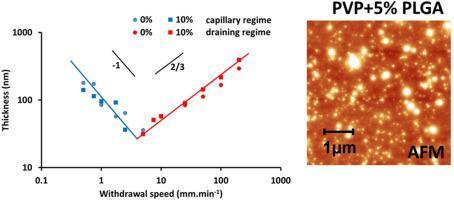当前位置:
X-MOL 学术
›
Colloids Surf. A Physicochem. Eng. Aspects
›
论文详情
Our official English website, www.x-mol.net, welcomes your
feedback! (Note: you will need to create a separate account there.)
Influence of PLGA nanoparticles on the deposition of model water-soluble biocompatible polymers by dip coating
Colloids and Surfaces A: Physicochemical and Engineering Aspects ( IF 4.9 ) Pub Date : 2021-01-01 , DOI: 10.1016/j.colsurfa.2020.125591 Christophe Sinturel , Marylène Vayer , Frédéric Mahut , Franck Bonnier , Igor Chourpa , Emilie Munnier
Colloids and Surfaces A: Physicochemical and Engineering Aspects ( IF 4.9 ) Pub Date : 2021-01-01 , DOI: 10.1016/j.colsurfa.2020.125591 Christophe Sinturel , Marylène Vayer , Frédéric Mahut , Franck Bonnier , Igor Chourpa , Emilie Munnier

|
Abstract This work relies on the use of dip-coating at various withdrawal speeds to form nanocomposite films, with a detailed analysis of the influence of the mode of deposition on the nanoparticle (NP) concentration in the dried film. While the deposition of polymer solutions on the one hand and colloidal suspensions of NPs on the other hand have been separately studied by dip coating, their combination is far being a simple superposition of the two separate behaviors. The formation of nanocomposite thin films composed of model water-soluble biocompatible polymers (polyvinyl alcohol - PVA and polyvinylpyrrolidone - PVP) loaded with poly(lactic-co-glycolic acid) (PLGA) nanoparticles (NPs) was studied through a dip coating process. Flat silicon substrates were removed at a controlled withdrawal speed from an aqueous colloidal suspension. Thin films of PLGA NPs with concentrations ranging from 1 to 10 % wt./wt. in PVA or PVP matrices were prepared. The presence of nanoparticles on the well-established process of thin film deposition was examined, as well as the influence of the deposition regime on the nanoparticle concentration in the deposited coating. We demonstrate that the presence of colloidal dispersion of PLGA nanoparticles in water solution of PVA and PVP does not modify the process of film deposition by dip coating. A typical “V” shaped curve was observed, with two well-known deposition regimes: capillary and draining modes respectively obtained at low and high withdrawal speeds. Due to crystallization at low withdrawal speed (favored by slow evaporation of the solvent) it was not possible to identify individual PLGA nanoparticles by AFM in the case of the PVA matrice. Amorphous PVP nanocomposite films were successfully prepared by dip coating, and allowed us to identify individual PLGA nanoparticles with AFM. Because of the prevalence of an evaporation-driven phenomenon at low withdrawal speed, incorporation of NPs was observed over the whole range of withdrawal speeds, showing original behavior compared to recent studies relying on a pure Landau-Levich regime (i.e. non-evaporative systems). Our results indicate that the nanoparticles were not equally retrieved from the solution in the capillary and the draining regimes. This suggests that the balance between the viscous drag and the interfacial effects depends on the deposition mode and calls for a more detailed analysis of the physical processes involved in both regimes.
中文翻译:

PLGA纳米颗粒对浸涂法沉积模型水溶性生物相容性聚合物的影响
摘要 这项工作依赖于使用浸涂以不同的撤出速度来形成纳米复合薄膜,并详细分析了沉积模式对干燥薄膜中纳米颗粒 (NP) 浓度的影响。虽然一方面聚合物溶液的沉积和另一方面 NPs 的胶体悬浮液已通过浸涂单独研究,但它们的组合远是两种单独行为的简单叠加。通过浸涂工艺研究了由模型水溶性生物相容性聚合物(聚乙烯醇 - PVA 和聚乙烯吡咯烷酮 - PVP)负载聚(乳酸 - 共 - 乙醇酸)(PLGA)纳米粒子(NP)组成的纳米复合薄膜的形成。以受控的撤出速度从水性胶体悬浮液中移除平坦的硅基材。PLGA NPs 薄膜,浓度范围为 1 至 10 % wt./wt。在 PVA 或 PVP 基质中制备。检查了纳米颗粒在薄膜沉积的完善过程中的存在,以及沉积方式对沉积涂层中纳米颗粒浓度的影响。我们证明 PLGA 纳米粒子在 PVA 和 PVP 的水溶液中胶体分散体的存在不会改变通过浸涂的薄膜沉积过程。观察到典型的“V”形曲线,具有两种众所周知的沉积方式:毛细管和排水模式,分别在低和高提取速度下获得。由于在低提取速度下结晶(有利于溶剂的缓慢蒸发),在 PVA 基质的情况下,不可能通过 AFM 识别单个 PLGA 纳米颗粒。通过浸涂成功制备了无定形 PVP 纳米复合薄膜,并允许我们使用 AFM 识别单个 PLGA 纳米颗粒。由于蒸发驱动现象在低提取速度下普遍存在,因此在整个提取速度范围内都观察到了纳米颗粒的掺入,与最近依赖纯朗道-列维奇体系(即非蒸发系统)的研究相比,显示出原始行为. 我们的结果表明,纳米颗粒在毛细管和排水系统中的溶液回收率不同。这表明粘性阻力和界面效应之间的平衡取决于沉积模式,并要求对这两种状态所涉及的物理过程进行更详细的分析。并允许我们使用 AFM 识别单个 PLGA 纳米粒子。由于蒸发驱动现象在低提取速度下普遍存在,因此在整个提取速度范围内都观察到了纳米颗粒的掺入,与最近依赖纯朗道-列维奇体系(即非蒸发系统)的研究相比,显示出原始行为. 我们的结果表明,纳米颗粒在毛细管和排水系统中的溶液回收率不同。这表明粘性阻力和界面效应之间的平衡取决于沉积模式,并要求对这两种状态所涉及的物理过程进行更详细的分析。并允许我们使用 AFM 识别单个 PLGA 纳米粒子。由于蒸发驱动现象在低提取速度下普遍存在,因此在整个提取速度范围内都观察到了纳米颗粒的掺入,与最近依赖纯朗道-列维奇体系(即非蒸发系统)的研究相比,显示出原始行为. 我们的结果表明,纳米颗粒在毛细管和排水系统中的溶液回收率不同。这表明粘性阻力和界面效应之间的平衡取决于沉积模式,并要求对这两种状态所涉及的物理过程进行更详细的分析。在整个提取速度范围内观察到 NP 的掺入,与最近依赖于纯朗道-列维奇体系(即非蒸发系统)的研究相比,显示出原始行为。我们的结果表明,纳米颗粒在毛细管和排水系统中的溶液回收率不同。这表明粘性阻力和界面效应之间的平衡取决于沉积模式,并要求对这两种状态所涉及的物理过程进行更详细的分析。在整个提取速度范围内观察到 NP 的掺入,与最近依赖于纯朗道-列维奇体系(即非蒸发系统)的研究相比,显示出原始行为。我们的结果表明,纳米颗粒在毛细管和排水系统中的溶液回收率不同。这表明粘性阻力和界面效应之间的平衡取决于沉积模式,并要求对这两种状态所涉及的物理过程进行更详细的分析。
更新日期:2021-01-01
中文翻译:

PLGA纳米颗粒对浸涂法沉积模型水溶性生物相容性聚合物的影响
摘要 这项工作依赖于使用浸涂以不同的撤出速度来形成纳米复合薄膜,并详细分析了沉积模式对干燥薄膜中纳米颗粒 (NP) 浓度的影响。虽然一方面聚合物溶液的沉积和另一方面 NPs 的胶体悬浮液已通过浸涂单独研究,但它们的组合远是两种单独行为的简单叠加。通过浸涂工艺研究了由模型水溶性生物相容性聚合物(聚乙烯醇 - PVA 和聚乙烯吡咯烷酮 - PVP)负载聚(乳酸 - 共 - 乙醇酸)(PLGA)纳米粒子(NP)组成的纳米复合薄膜的形成。以受控的撤出速度从水性胶体悬浮液中移除平坦的硅基材。PLGA NPs 薄膜,浓度范围为 1 至 10 % wt./wt。在 PVA 或 PVP 基质中制备。检查了纳米颗粒在薄膜沉积的完善过程中的存在,以及沉积方式对沉积涂层中纳米颗粒浓度的影响。我们证明 PLGA 纳米粒子在 PVA 和 PVP 的水溶液中胶体分散体的存在不会改变通过浸涂的薄膜沉积过程。观察到典型的“V”形曲线,具有两种众所周知的沉积方式:毛细管和排水模式,分别在低和高提取速度下获得。由于在低提取速度下结晶(有利于溶剂的缓慢蒸发),在 PVA 基质的情况下,不可能通过 AFM 识别单个 PLGA 纳米颗粒。通过浸涂成功制备了无定形 PVP 纳米复合薄膜,并允许我们使用 AFM 识别单个 PLGA 纳米颗粒。由于蒸发驱动现象在低提取速度下普遍存在,因此在整个提取速度范围内都观察到了纳米颗粒的掺入,与最近依赖纯朗道-列维奇体系(即非蒸发系统)的研究相比,显示出原始行为. 我们的结果表明,纳米颗粒在毛细管和排水系统中的溶液回收率不同。这表明粘性阻力和界面效应之间的平衡取决于沉积模式,并要求对这两种状态所涉及的物理过程进行更详细的分析。并允许我们使用 AFM 识别单个 PLGA 纳米粒子。由于蒸发驱动现象在低提取速度下普遍存在,因此在整个提取速度范围内都观察到了纳米颗粒的掺入,与最近依赖纯朗道-列维奇体系(即非蒸发系统)的研究相比,显示出原始行为. 我们的结果表明,纳米颗粒在毛细管和排水系统中的溶液回收率不同。这表明粘性阻力和界面效应之间的平衡取决于沉积模式,并要求对这两种状态所涉及的物理过程进行更详细的分析。并允许我们使用 AFM 识别单个 PLGA 纳米粒子。由于蒸发驱动现象在低提取速度下普遍存在,因此在整个提取速度范围内都观察到了纳米颗粒的掺入,与最近依赖纯朗道-列维奇体系(即非蒸发系统)的研究相比,显示出原始行为. 我们的结果表明,纳米颗粒在毛细管和排水系统中的溶液回收率不同。这表明粘性阻力和界面效应之间的平衡取决于沉积模式,并要求对这两种状态所涉及的物理过程进行更详细的分析。在整个提取速度范围内观察到 NP 的掺入,与最近依赖于纯朗道-列维奇体系(即非蒸发系统)的研究相比,显示出原始行为。我们的结果表明,纳米颗粒在毛细管和排水系统中的溶液回收率不同。这表明粘性阻力和界面效应之间的平衡取决于沉积模式,并要求对这两种状态所涉及的物理过程进行更详细的分析。在整个提取速度范围内观察到 NP 的掺入,与最近依赖于纯朗道-列维奇体系(即非蒸发系统)的研究相比,显示出原始行为。我们的结果表明,纳米颗粒在毛细管和排水系统中的溶液回收率不同。这表明粘性阻力和界面效应之间的平衡取决于沉积模式,并要求对这两种状态所涉及的物理过程进行更详细的分析。











































 京公网安备 11010802027423号
京公网安备 11010802027423号